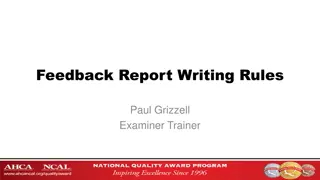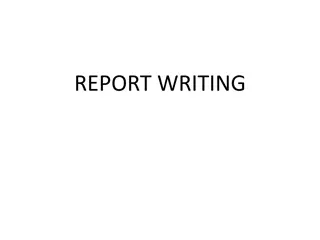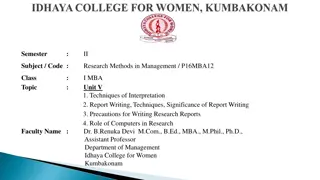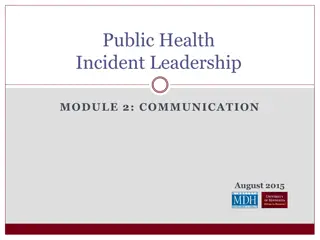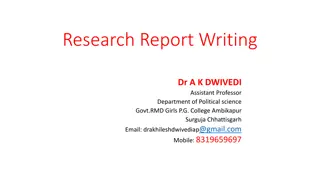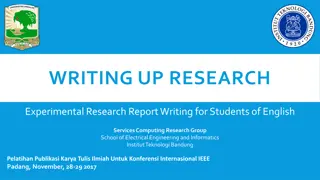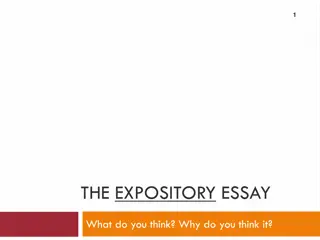Importance of Research Report Writing in Effective Communication
Effective research report writing is crucial for communicating ideas, findings, and knowledge to the reader and society. It serves as a means to present research obligations, review preceding steps, and share valuable insights with the community. The essentials of a good research report include clarity of thought, careful use of terminology, data collection, analysis methods, and structured presentation. The conventional structure of a research report typically comprises a preliminary section, main body, and references section, emphasizing the significance of written communication in research dissemination.
- Research report writing
- Effective communication
- Knowledge sharing
- Research obligations
- Data analysis
Download Presentation

Please find below an Image/Link to download the presentation.
The content on the website is provided AS IS for your information and personal use only. It may not be sold, licensed, or shared on other websites without obtaining consent from the author. Download presentation by click this link. If you encounter any issues during the download, it is possible that the publisher has removed the file from their server.
E N D
Presentation Transcript
J. Baker: The communication of ideas from writer to the reader is called report writing . Reddy: It is the statement that contains in brief the procedure adopted and findings arrived in brief by the researcher. Goode & Hatte: A report represents knowledge and wisdom of the report writer on one hand and his drafting pattern capacity on the other. Real report writing means effective and purposeful communication with society.
Research obligations It is the final stage of the research process All research projects must be presented in a report form so that readers could acknowledge and criticize endeavour The report includes a review of the preceding steps to help others evaluate the research The most carefully designed and conducted study, the most striking findings are of no use unless they are communicated to others The purpose of research is the search for knowledge for the sake of people and the researcher has an ethical obligation to report to the community what has emerged in his research report writing is an important professional the research
Research without writing is of little purpose. There are of course , many other ways of communicating your research and findings, most notably oral presentation but writing them up remains of paramount importance. The research report, thesis, the journal article, academic text and conference papers remain the major means by which researchers communicate with each other, and with other interested parties. The rapid development of new information and computer technologies may have changed the speed and scope of such communication but it has not altered the importance of writing as a means for communicating.
Essentials of a Good Research Report Clarity of thoughts (problem) Careful use of concepts and terminologies Methods of data collection Methods of presentation data analysis Flow of language Chapterization of report Inclusion of essential data Use of footnotes/references
The conventional structure of a research report consists of THREE parts as A. The Preliminary Section B. The Main Body C. References Section
Research Report Format A Preliminary Section 1. Title Page 2. Approval Sheet 3. Abstract/Summary 4. Acknowledgements 5. Abbreviations 6. Table of contents 7. List of Tables 8. List of Diagrams/Graphs
Section B: The Main Body A. Introduction B. Review of Literature C. Research Design and Methodology D. Presentation and Analysis of Data E. Conclusions and Recommendations Section C: References Section A. Bibliography B. Appendix
Title Page of the Report The title of the study should be brief and precise. It should be self explanatory The title should reflect the nature of the study It should be focused Most readers are attracted to buy a book or read a report simply because of its title Vague topics are misleading and should therefore be avoided The title page includes A precise title of the report Name of the Author (s) Monogram of the organization Year Name of funding organization
Factors Responsible for Women Criminality in Khyber Pukhtunkhwa, Pakistan Akhtar Munir M.A. Social Work Session 2012 14 Department of Social Work University of Peshawar
Factors Responsible for Women Criminality in Khyber Pukhtunkhwa, Pakistan A thesis submitted to the University of Peshawar in partial fulfillment for the award of Masters of Arts Degree in Social Work Submitted by SaleemAkhtar M.A. Social Work Session 2010-11 Department of Social Work University of Peshawar
Approval Sheet Research Conducted by SaleemAkhtar ____________________ Supervised by/Internal Examiner Farhana Noureen Lecturer ____________________ External Examiner ____________________ Date: ____________________
Abstract An abstract is expected to summarize the contents of the report It is a brief digest of the whole report It allow other people to see, at a glance, if the research is relevant to their needs and worth tracking down to read in full. An abstract is normally about 250 300 words in length and is presented on a separate sheet An abstract should not include citation to other research works
Acknowledgements It is conventional to acknowledge the assistance of people who helped during the course of your study. It can be the funders, a academic supervisor, friends, supporters, who made a significant contribution to the research.
List of Abbreviations If many abbreviations have been used in the report, it is needed to be listed , usually alphabetically alongside the full version of what they stand for.
Table of Contents A report should have a Table of Contents It usually includes chapter headings and sub-headings along with page numbers In addition, Appendix and bibliography should also be listed in the table of contents.
List of Tables/diagrams This should list the titles/ headings of various tables and figures and their location (page no.)
Preface This provides the opportunity for the researcher to give a personal statement about the origins of the research and the significance of the research for the researcher as a person. In view of the importance of the self in the research process, the Preface offers a valuable place in the research report to explore, albeit briefly, how the research reflects the personal experience and biography of the researcher
Chapter 1: Introduction 1.1 Statement of the problem 1.2 Significance of the study 1.3 Chapterization of the report 1.4 Limitations of the study
Chapter 2: Review of Literature Acknowledge previous researches Criticize previous researches Find gaps that you want to fulfill in your research Give name to each and every chapter You can have as many chapters as you think is necessary
Chapter 3: Research Design and Methodology Purpose of the study Objectives of the study Universe of the study Sampling Sample technique Sample size Tools of data collection Pre-testing Duration of the study
Chapter 4: Presentation and Analysis of Data Tables and their descriptions Diagrams/Graphs Analysing and interpreting data is the process of systematically organizing the interview transcripts, field notes, and other materials you have collected; bringing meaning to them so they tell a coherent story; and writing it all up so that others can read what you have learned. It entails organizing these materials into chunks (analysis) and bringing meaning to those chunks (interpretation). One way to think about analysis is that it begins at the same time as a study does - at the conceptualization stage. The conceptual framework of the study, the research questions and the strategy for research and design. The purpose of analysing the data is to find meaning in the data, and this is done by systematically arranging and presenting the information.
After the collection of data, it needs to be properly organized so that to provide answers to the research questions, to suggest for the solution of the problem or to test hypothesis There is no hard and fast rules for data analysis, however, analysis must give meaning to data, however, the raw data is handled in some manner so that to make sense of it The raw data may be in the form of interview schedules, questionnaires, field notes, observations, audio tapes, video tapes, photographs, or in any other shape If the data is on audio or video tape, it is important to record data on an interview transcript/paper. It is important to go through all the interview transcripts, edit them, put them in sequence, make sure that all the questionnaires are properly filled.
Chapter 5: Conclusions and Recommendations Discussion of the problem understudy along with the findings of the study The researcher finally arrive at some general conclusions and suggest some way forward. This part of the report should be constructive and positive and should contain points; Overall evaluation of the research and its contribution Recommendations for improving the situation Identification of new directions for further researches
Section C: References Section C References Section Bibliography Appendix This is the place for materials which is too bulky for the main body of the text. Typical things that can be lodged in an appendix are; Complicated tables Questionnaires used in the study Extracts from an interview transcripts





